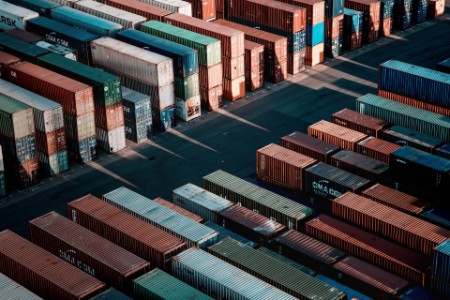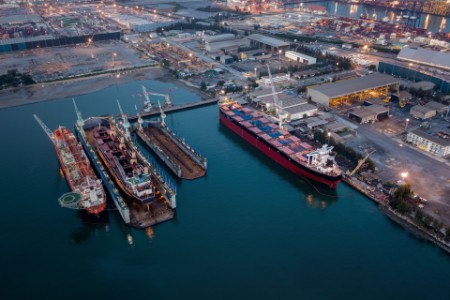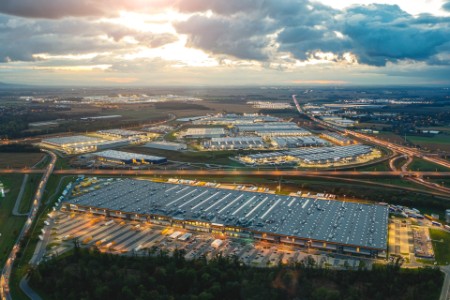
Chapter 1
External forces are upending the industrial supply chain status quo
Global events, wage inflation and increasing protectionism are affecting supply chains.
According to the World Trade Organization, global merchandise trade volume exceeded US$22 trillion in 2021, which represented a more than tenfold increase over 1980. The expansion of global supply chains fueled this explosion, together with major geopolitical developments that opened markets and sources of supply. Companies re-engineered their supply chains to add production sites and suppliers in Mexico, Romania, China, Vietnam and other lower-cost countries.
These tactics proved extremely cost-effective but came with inevitable trade-offs. Added complexity and physical distance, combined with innovations like just-in-time inventory management, left global supply chains more vulnerable to external disruptions.
Over the last few years, several key factors have wreaked havoc on global supply chains:
COVID-19 pandemic
More than two years in, the pandemic continues to upend global supply chains. Nearly half of survey respondents experienced disruption from logistics-related delays (45%) and production input shortages or delays (48%), and more than half (56%) saw disruption from production input price increases.
Despite cautious optimism in early 2022, this spring’s ongoing lockdowns in key Chinese industrial hubs underscore that uncertainty and risk associated with the virus – and related government policies – are unlikely to abate in the near term, heightening the imperative for companies to act.
Increasing protectionism
Beyond the pandemic, global supply chains face risks from government policies encouraging domestic industries and impeding cross-border goods and capital flows. Definitions of nationally sensitive industries and technologies have also been expanded in multiple countries, increasing limits on foreign direct investment.
Nearly a quarter (24%) of survey respondents said their company’s operations or supply chains were significantly disrupted over the past 24 months by new tariffs or other government-driven trade regulations or restrictions, maintaining pressure on companies to optimize the locations of their operations and suppliers. This increasingly means a shift closer to home, dovetailing with the increasing benefits of shortened supply chains amid the pandemic’s logistics snarls.
The war in Ukraine
Beyond its horrific human cost, the war in Ukraine has had direct implications for global supply chains: increased energy and raw material costs; devastated regional industry; raised cyberattack fears; and increased operational complexity as companies navigate new sanctions and heightened scrutiny of existing business relationships.
Indirectly, the range of policy measures deployed against Russia, and the potential for secondary sanctions against countries maintaining more normal relations (e.g., China or India), may lead countries to inoculate themselves and their domestic industries against similar measures by selectively decoupling their existing supply chains. Similarly, foreign companies with operations or suppliers in such countries must engage in contingency planning that considers the sudden and potentially protracted loss of these assets or relationships.
Wage inflation in lower-cost countries
For years, wages in certain lower-cost countries have been rising faster than in other regions. In 2020, industrial companies experienced surging labor cost growth in places like China, compared with more modest changes in Europe and the US. The trend in China is expected to continue for the foreseeable future as multiple Chinese provinces increase their minimum wages and the yuan remains relatively strong. As a result, some industrial companies operating in China have relocated production, a development that may continue if not sufficiently counterbalanced by other factors.

Chapter 2
Rethinking global supply chain models
EY Industrial Supply Chain Survey respondents are countering disruption by transforming.
The results of the EY Industrial Supply Chain Survey demonstrate the extent to which companies are already responding to this disruption by transforming their global supply chains. Significant decoupling of existing supply chains is underway: 53% of respondents say they have already near- or re-shored some of their operations in the last 24 months, and 44% say they are planning new or additional near-shoring activities in the next 24 months. To increase geographic diversity and reduce risk, 57% say they have established new (i.e., not relocated) operations in one or more additional countries in the last 24 months and 53% are planning to do so in the next 24 months.
Steps toward resiliency
53%of industrial companies say they have near- or re-shored operations in the last 24 months.
Changes to supplier bases are even more prevalent: 62% of respondents said their companies have made significant changes in this area in the last 24 months, and 55% say they are planning significant changes in the next 24 months. For these companies, increased diversification and proximity to their customers are key outcomes. Respondents also said they are increasing their total number of suppliers (77%) and the number of countries in which they have suppliers (63%). Large percentages also said these changes shifted their supplier footprint closer to their operations (55%) and their customers (47%).
Steps toward resiliency
62%of industrial companies say they have made significant changes to their supplier base in the last 24 months.
These changes appear to trade lower costs for increased resiliency – at least in the short term. Nearly 60% of respondents who have taken or are planning such actions expect short-term (22%) or long-term (37%) cost increases as a result. However, many are also planning a range of offsetting actions, such as investments in robotics and automation to reduce labor costs (58%), temporary or permanent price increases (41%/40%), and various other efficiency-improving or cost-cutting measures (37%).

Chapter 3
Regions and sectors are taking different approaches
Three geographies and four sectors demonstrate how specific factors influence how companies are responding.
While many of the supply chain headwinds and countermeasures are consistent across regions, some notable differences do exist. Drivers include the primary position of each locale within global supply chains (i.e., origin vs. destination), government policies, and differences in existing offshoring strategies.
North America
In response to ongoing pandemic-related disruptions, industrial firms in North America have begun to bring production and suppliers closer to home to reduce complexity and ease delays. This movement has been amplified by the US government’s support for domestic manufacturing and sourcing.
For example, several major US and foreign automakers have announced major investments in electric vehicle (EV) battery manufacturing plants while also working (with US government policy assistance) to domestically source more critical raw materials. This reflects a bet that the EV future demands supply chains that are both closer to customers and insulated from trade issues – particularly with respect to China. Leading industrial products manufacturers have also recently announced investments in the US and Mexico to shorten their supply chains, reduce risks, and position themselves closer to their North American markets.
The EY survey shows the anecdotal evidence reflects broad trends. A majority of US respondents (52%) say they have near- or re-shored operations in the last 24 months. Supplier base changes are even more prevalent, with 60% of US respondents saying their companies have made significant changes in this area in the last 24 months.
The uncertain future of the critical US-China relationship suggests these general trends will continue. A few hopeful signs (e.g., the Biden administration’s recent decision to restore some tariff exemptions on Chinese goods) do not offer much evidence against expectations of continued economic decoupling. The divergent responses to Russia’s invasion of Ukraine underscore this as well, making it essential that firms carefully assess their supply chain architectures today to identify and mitigate excessive risk.
US respondents
52%say they have near- or re-shored operations in the last 24 months.
US respondents
60%say they have made significant changes to their supplier base in the last 24 months.
Europe
Prior to the pandemic, supply chain transformation was generally less in focus for European industrial firms than in North America, both due to the absence of geopolitical tensions on the level of US-China (Brexit aside) and generally closer proximity to lower cost operations and suppliers in Eastern Europe and Asia. However, persistent pandemic-related issues and regulatory measures like the EU’s Carbon Border Tax have prompted European companies to increasingly re-assess their supply chain architectures. The sudden and wide-ranging effects of the war in Ukraine will only reinforce this trend.
Based on survey responses from companies based in Germany, France, Spain, Italy, and the UK, the extent of operational relocation among European industrial players is similar to the US, with 55% saying they have engaged in near- or re-shoring in the last 24 months. European respondents were also likely to have made supplier base changes, with 61% saying they had done so in the last 24 months.
However, as these results were collected in March 2022, it is doubtful they fully capture the impact of war on companies’ outlooks. Given the extensive challenges related to everything from component availability (e.g., lack of automotive wire harnesses from Ukrainian suppliers) to logistics (e.g., Asia-Europe cargo routes disrupted by Russian airspace closure), European companies will be under increasing pressure to further rethink their supply chain strategies.
European respondents
55%say they have near- or re-shored operations in the last 24 months.
European respondents
61%say they have made significant changes to their supplier base in the last 24 months.
China
In China, the competitive industrial system, rapidly expanding domestic consumption and the Dual Circulation Strategy to place greater emphasis on its domestic market and reduce reliance on exports are driving greater independence and internal focus. Elements of the 14th Five-Year Plan (2021-25) are devoted to cultivating manufacturing clusters in key industries (e.g., integrated circuits, aerospace, robotics, advanced power equipment, engineering machinery and others) to promote local economic development. The goods from these clusters would support the aim of greater “internal circulation” or domestic consumption while also increasing “external circulation” via increased competitiveness in the global export market.
Perhaps consistent with these governmental imperatives, Chinese firms’ responses to the EY survey indicate levels of operational and supply base reshaping in line with or greater than firms in other surveyed regions. Sixty-five percent of Chinese respondents say they have near- or re-shored operations in the last 24 months. Seventy-five percent say they have made significant supplier base changes over the same period.
Chinese respondents
65%say they have near- or re-shored operations in the last 24 months.
Chinese respondents
75%say they have made significant changes to their supplier base in the last 24 months.
With heightened geopolitical tensions and other disruptions, decoupling has increasingly surfaced as a trend to watch – particularly for foreign firms operating in China. For example, a US industrial manufacturer recently shuttered a 1,000-worker factory after 25 years of operation, with tariffs cited as a likely driver. Similarly, a Japanese electronic components player announced a new production facility in Thailand to help diversify its supply chain away from China.
However, given the size and growth profile of its market, the need to have a footprint “in China, for China” precludes full decoupling by any company aspiring to compete against strong domestic players. Rather, more measured adjustments like “China plus one” strategies will be increasingly adopted to preserve foreign firms’ past investments and market access while also improving supply chain resilience.
Selected sector observations
Firms across industrial sectors are taking steps to restructure their supply chains and remain competitive in the face of these massive external forces, with approaches varying based on relative value chain positioning, operational complexity and political sensitivity.
- Aerospace and defense companies are somewhat ahead of the curve with shorter, domestically oriented supply chains, given the sensitive nature of defense technologies. However, they continue to shift production closer to demand hubs to further improve resiliency, while employing technologies like additive manufacturing and automation to preserve margins.
- Automotive companies are shortening their supply chains by sourcing from local suppliers and building battery plants closer to US and European markets. Many automotive manufacturers have also shifted some production and raw material sourcing out of China in favor of North America, Europe and other parts of Asia to keep production lines moving, despite higher costs.
- Chemicals companies are diversifying supplier bases and expanding capacities closer to demand hubs. Many leading multinationals are investing heavily in China via joint ventures, partnerships and capacity expansions to ensure country-wide positioning alongside manufacturers serving both international and domestic markets. Others are simultaneously adding capacity in the US, India and other countries in Asia to reduce risk.
- Diversified industrial products manufacturers are investing to shorten their supply chains for major markets and diversify their supplier bases. Large companies are accelerating plans to add new factories in North America to simplify logistics. Some are also pursuing acquisitions to secure cost-effective access to local markets with lower tariff risk.

Chapter 4
Building the industrial supply chain of the future
Industrial leaders need to focus on five key priorities.
Global supply chains are undergoing a seismic shift as companies depart from the strategies that prioritized ultra-low costs, just-in-time delivery and bare minimum inventories. To remain competitive, industrial leaders need to focus on five key priorities to fundamentally transform their supply chains and prepare for the future:
1. Rapidly redefine your supply chain strategy
Carefully assess your global product flows, tax models and network footprint, and implement a supply chain architecture that can handle new risks and opportunities.
2. Design and build agility into your supply chain footprint and supplier network
Improve your responsiveness through real-time monitoring and scenario planning. Shift the mindset of your team and partners toward visibility and trust from command and control.
3. Optimize your working capital profile
Use supply chain reinvention as an opportunity to drive a significant change in your working capital profile by leveraging analytics and automation.
4. Embrace sustainability
Engage suppliers and partners to drive competitive advantage and environmental outcomes via circular economy principles. Link corporate responsibility to your organization’s vision and purpose.
5. Move from doing digital to being digital
Implement supply chain technologies that enable new revenue streams rather than focusing solely on efficiencies. Close the talent gap in digital fluency and navigate the challenges of emerging digital taxes.
Like the globalization wave that preceded it, the current supply chain evolution will take several decades to unfold, and it will look different across regions and sectors. However, it is clear that this transformation has the potential to radically alter established supply chain models around the world. Given the massive impact of external forces affecting economies around the world, industrial firms need to come to terms that change is coming – and that there will be winners and losers as part of this process.
A special thank you to Joe Gaynor, EY Americas Global Development Lead AM&M Origination and Infrastructure and Christian Hainz, EY Global AM&M Senior Analyst, Knowledge for their contributions to this article.
Related articles
Summary
Reimaging and transforming supply chains can be costly, especially given how heavily some firms have invested in offshoring manufacturing and developing international supplier networks. But it is an important step for companies to remain competitive.

